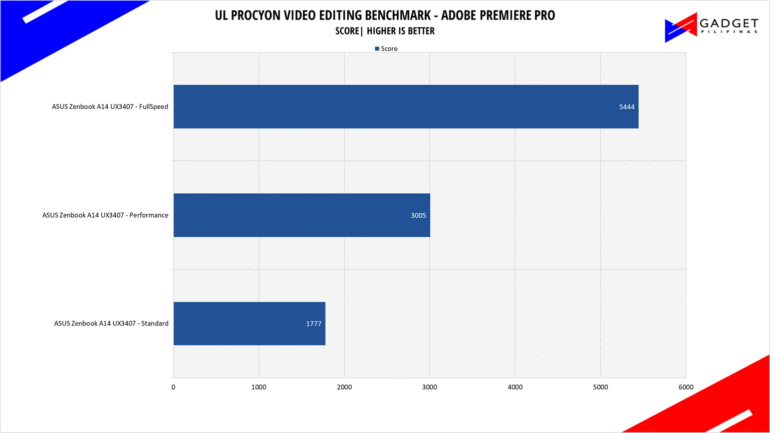ASUS has been one of the most supportive brands when it comes to Qualcomm’s ARM CPUs. Unlike most brands, ASUS incorporates its latest technologies, and, in some cases, introduces exclusive innovations on its Qualcomm-powered devices. This approach has made ASUS’ ARM-based offerings stand out in the market, despite having tough competition from AMD’s Ryzen AI MAX and Intel’s Core Ultra lineup. This time around, we have a budget option, the ASUS Zenbook A14 that’s equipped with a Qualcomm Snapdragon X X1 26100.
ASUS Zenbook A14 UX3407 – A Closer Look


ASUS doubles down on its Ceraluminum material with the ASUS Zenbook A14, making it ASUS’ second laptop and its first Qualcomm-based device to sport a Ceraluminum Build. It’s ASUS’ lightest laptop to date, weighing only 899 grams. The ASUS Zenbook A14 UX3407 is available in Iceland Gray and Zabriskie Beige colorway.

Port selection on the ASUS Zenbook A14 is about the bare minimum of what you would expect on a thin and light laptop. The left side houses two USB Type-C Ports, one HDMI 2.1 port, and one Audio combo jack.

The right side houses one USB 3.2 Gen 2 Type-A port. Bandwidth isn’t an issue on the Zenbook A14, albeit it would’ve been nice to see another USB port, as at least one type-C port is dedicated to charging.

The Ceraluminum build and finish are consistent all throughout the lapto,p providing a very premium feel. And when you pair it with its incredible 899g weight, it sure makes the ASUS Zenbook A14 feel like a six-digit device.

As mentioned in previous ASUS Zenbook laptop reviews, having the power button integrated in the keyboard deck is a generally bad idea, especially with the placement being next to the delete and backspace buttons. ASUS has every opportunity to make its 30th anniversary logo double as a power button and also as a fingerprint reader for Windows Hello support.

ASUS has been consistent with its large trackpads across all of its laptops, and to achieve such a large footprint in a relatively thin and light chassis is very impressive. That said, its thinness is a double edge sword as you have a less crispy tactile feedback and a shallower bottom out feel when pressing the touchpad.
ASUS Zenbook A14 UX3407 – Display and Camera

The Zenbook A14 UX3407 has a 14-inch WUXGA 1920 x 1200P 16:10 IPS display running at 60Hz. ASUS has been known for aggressively pushing OLED displays on its laptops. It’s quite surprising and disappointing to see that the Zenbook A14 UX3407 only has an IPS display, as most, if not all, current generation Zenbooks and even majority of Vivobook laptops sport an OLED display.



Despite being an IPS display, the color gamut is actually above average as we measured 100% sRGB, 76% AdobeRGB, and 78% DCI-P3 using our SpyderX Pro Display Analysis Tool. It’s color accurate enough to do some photo and video editing.

Qualcomm-based laptops are known to have better webcams due to the CPU’s image processing but the lower quality camera on the Zenbook A14 this time around doesn’t help Qualcomm’s case.
MyASUS Software


MyASUS software lets you manage the laptop’s settings alongside its performance profiles. The suite also lets you update the laptop’s drivers and even BIOS settings alongside diagnostic and support tools.
Benchmark Setup and Test Methodology
Gadget Pilipinas’ testing philosophy is to provide detail-oriented results as accurately as possible so that our readers can replicate our tests given that these conditions are met. Different benchmarking apps and sequences are used depending on the tested component or device.
We use CapFrameX 1.7.2 Beta as our primary FPS capture and analysis tool for all our gaming benchmarks. The latest build version of Windows 11 Pro and WHQL-certified drivers are used for our benchmarks. Readings such as temperatures and power draws are recorded using HWINFO64, and OCCT Enterprise.
We benchmarked the ASUS Zenbook together with its different power profile settings found in the MyASUS Software – Standard, Performance, and Full Speed. The main purpose of benchmarking power profiles is to show how aggressive or conservative the manufacturer is in terms of thermal management. These profiles will affect the CPU and GPUs’ boosting behavior in terms of duration and max clock speed, translating to higher scores and stable frame rates.
As part of our 2024 laptop benchmark methodology revamp, we’ve changed how these profiles are tested. Synthetic and Productivity benchmarks include all of the power profiles. We decided to drop the silent or power-saving profile for gaming benchmarks as these lowest profiles generally produce unplayable frame rates, especially at 1440p and above resolutions. Moreover, games are tested at the laptop’s native resolution as we expect most, if not, all, gamers to game on the laptop’s native resolution.
For more information, read our Benchmark Methodology article.
ASUS Zenbook A14 UX3407 Synthetic and Productivity Benchmarks
OCCT Benchmark

OCCT is a popular benchmark and stability testing tool among overclockers, enthusiasts and system integrators
CINEBENCH 2024 – ARM EDITION

Maxon’s Cinebench benchmark is one of the most iconic benchmark applications used by reviewers and enthusiasts. The latest Cinebench 2024 uses the latest rendering architectures, including Intel’s Embree ray tracing technology and other advanced features from AMD and Intel that allow users to render the same scene on the same hardware.
PROCYON – ADOBE PREMIERE PRO VIDEO EDITING BENCHMARK

Procyon benchmark suite is developed by the UL, the same team behind 3DMark and PCMark benchmarks. The UL Procycon video editing benchmark uses Adobe Premiere in a typical video editing workflow. The benchmark starts by importing two video project files with various edits, adjustments, and effects – the second project uses several GPU-accelerated effects. Each project is exported in 1080p with H.264 encoding and again in 4K with HEVC H.265. The reported score is based on the time taken to export all four videos.
V-RAY 6

V-Ray Benchmark is a stand-alone version of V-Ray developed by Chaos Group. It is designed to test the CPU and GPU by rendering sample scenes at a fixed amount of time. V-Ray is a plug-in mostly utilized by 3D computer graphics software applications mainly for industrial design, product design, architecture, film, and video game production. V-Ray is not limited to 64-threads as it supports multi and mega-threading.
SuperPI 32M

SuperPI is a single-threaded benchmark application that lets the CPU calculate Pi(π) to the nth digit. In this benchmark, we selected the Pi calculation to 32M, the highest available for the app.
wPrime 1024M

wPrime is a benchmark tool similar to SuperPI, but the former takes on finding prime numbers using Newton’s Method. The benchmark is set to calculate 1024 million prime numbers, and the performance is measured according to calculation time.
GeekBench 6.3

Geekbench is a multi-platform benchmark used to gauge CPU performance and compare them across Windows, Mac, and Mobile. Geekbench 6 is the latest version and doesn’t rely on memory more than the previous Geekbench 4, making it a great tool to measure both single-core and multi-core CPU performance.
CORONA RENDERER

Corona Renderer is an unbiased photorealistic render available for Autodesk 3Ds Max, Maxon Cinema 4D, and as a stand-alone application. Its popularity, similar to Blender, led Chaos Group to develop a benchmark version of the app which runs using Corona Renderer 1.3. Workstation systems, especially CPUs, can utilize Corona Benchmark as up to 72 threads can be used in the benchmark, making it very suitable for CPUs with various price segments.
BapCo CROSSMARK

Crossmark is one of the few native cross-platform benchmark tools available for Windows, Android, Linux ChromeOS, iOS, and macOS. It measures overall system performance and system responsiveness using models of real-world applications making it a great comparison point across multiple platforms.
ASUS Zenbook A14 UX3407 SSD Benchmark


ASUS surprisingly used a slightly faster SSD compared to what we’ve seen in Vivobook laptops with read speeds reaching up to 6,698 MB/s on our quick CrystalDiskMark 1GB Benchmark. That said, the 512GB SSD does fall short on Random read and writes but considering its capacity, it’s still one of the better SSDs found on an ultrabook.
ASUS Zenbook A14 UX3407 Battery Life

ASUS Zenbook A14 UX3407 sports a very impressive battery life considering it only has a 49.9wHr battery. Its battery life can compete with laptops sporting 80 to 99wHr batteries albeit these laptops have much more power hungry CPUs and displays. Nonetheless, Qualcomm still takes a jab against Intel and AMD in the battery life department as seen with the Zenbook A14
ASUS Zenbook A14 UX3407 Temperatures
There is clearly a lot of headroom left for optimization available on the Zenbook A14 and Qualcomm chips in general as looking at the temperatures comparing our brightness result shows a large delta from the standard profile and full speed. That said, Qualcomm chips have a different operating and thermal behaviour so it isn’t fair to judge the TJMax temps as similar to x86 chips. That said, we haven’t observed thermal throttling with the different performance profiles.
Conclusion

ASUS’ commitment to Qualcomm’s ARM lineup is nothing but impressive and commendable, as competition results in a net benefit in the industry, especially towards consumers. However, like with Microsoft, pairing the Qualcomm chips with their flagship Zenbook laptop line(for Microsoft, with their Surface Pro line) instead of creating a dedicated segment hurts the reputation and branding they’ve built over the years – this is the second case this time around for ASUS, the first one being the Vivobook S 15 S5507 that we reviewed last year.
The ASUS Zenbook A14 UX3407 exhibits premium build quality, as what you would on a Zenbook laptop. Albeit, it does have more qualities that make it more like a Vivobook especially with its lackluster performance and screen quality. The Zenbook A14’s Ceraluminum build and lightness are what make it a Zenbook laptop but falls short on every other aspect which makes me want to contest its Php 70,000 price tag.
Branding aside, the ASUS Zenbook A14 UX3407 shines in portability and battery life. Paired with its build quality, these three aspects are what the trifecta selling points of the Zenbook A14. Those who value battery life and portability above anything else and require no heavy compute whatsoever, only have the Zenbook A14 as a compelling option without paying for unneccessary extras that these types of users may or may not enjoy.
So, if you’re workload doesn’t require anything outside of the ordinary or mainly revolves around office apps, browsers, or email then the ASUS Zenbook A14 UX3407 provides with with exemplary battery life and feather weight portability somewhat justifying its price tag as it’s unique for its price. Else, if you need stronger compute or a better screen for a slightly thicker or heavier tradeoff, then there are x86 varaints that would fit your use-case.
Grant is a Financial Management graduate from UST. His passion for gadgets and tech crossed him over in the industry where he could apply his knowledge as an enthusiast and in-depth analytic skills as a Finance Major. His passion allows him to earn at the same time help Gadget Pilipinas' readers in making smart, value-based decisions and purchases with his reviews and guides.







